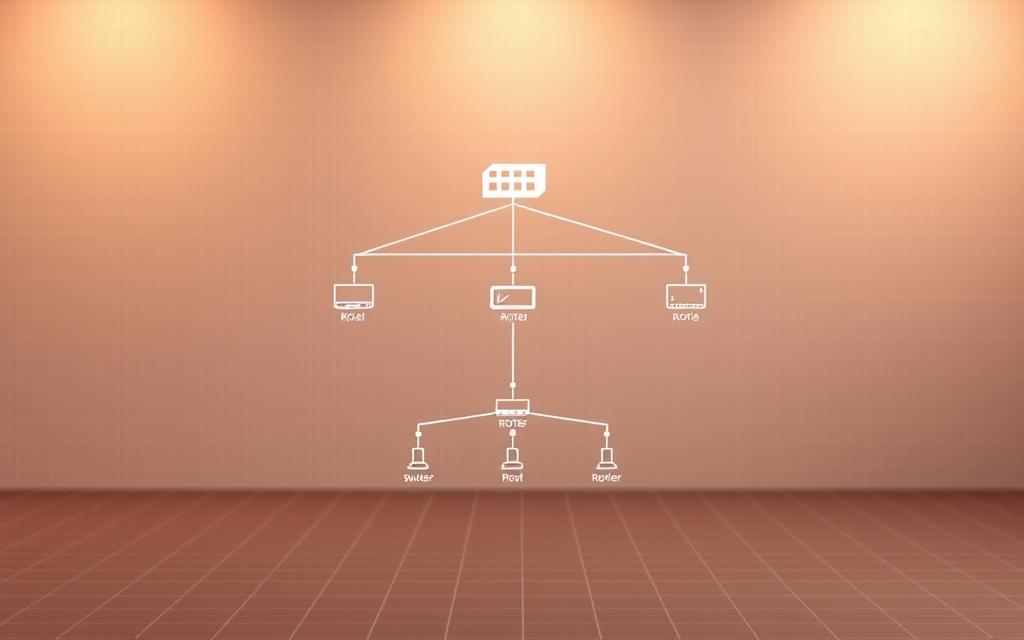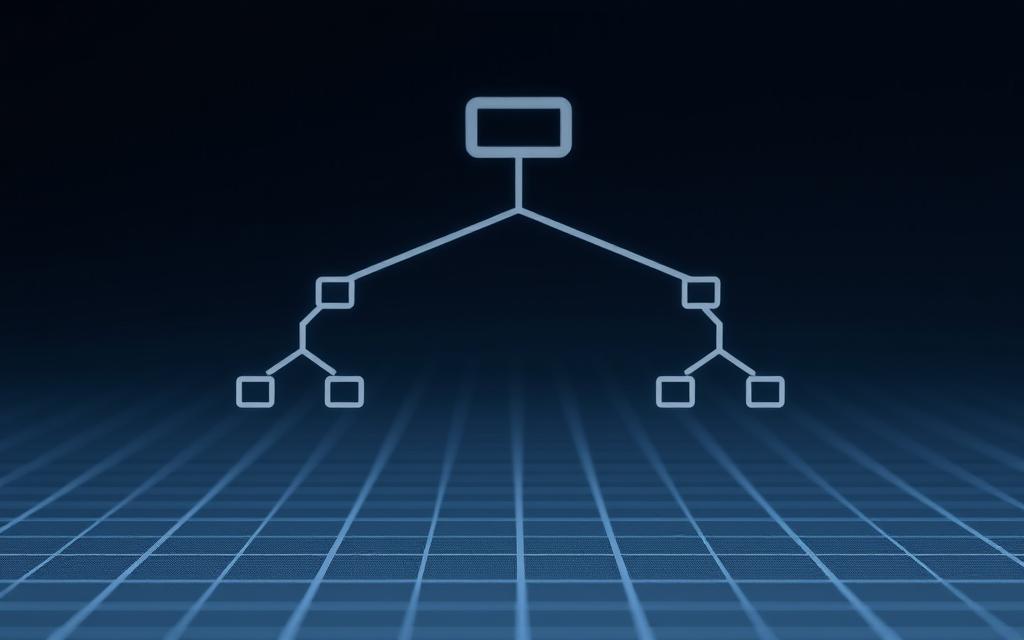Understanding Tree Topology in Computer Networks
Tree topology blends the best features of bus and star configurations, creating a hierarchical structure that resembles an inverted tree. At the top sits the root node, serving as the central connection point for all branches. This setup ensures a single pathway between any two nodes, preventing data collisions and enhancing efficiency.
This hybrid architecture is widely used in LANs and enterprise systems due to its structured scalability. By combining the backbone of a bus with the clusters of a star, it offers a balanced approach to network design. Often referred to as star bus topology, it provides a clear, organized framework for data flow.
For a deeper dive into how this topology works, check out this detailed guide. Understanding its principles lays the groundwork for exploring more advanced network configurations.
What Is Tree Topology in Computer Network?
This configuration uses a central root node to link multiple layers of child nodes. It forms a hierarchical structure, making it ideal for large-scale systems. The backbone cable acts as the trunk, branching out to star-configured hubs and switches.
Devices are organized in a parent-child relationship, resembling a tree’s root system. The central root node connects to secondary nodes, which further link to end devices. This multi-tiered design ensures efficient data flow and minimizes collisions.
Unlike pure star networks, this setup extends scalability through branch extensions. Each hub operates intelligently, managing data transmission within its cluster. This reduces the load on the central node and enhances overall performance.
| Component | Role |
|---|---|
| Root Node | Central connection point |
| Backbone Cable | Primary data pathway |
| Hubs/Switches | Connect end devices |
| End Devices | Final data recipients |
This network topology is highly scalable, making it suitable for growing organizations. By combining the backbone of a bus with the clusters of a star, it offers a balanced and efficient design.
How Tree Topology Works
Data flows seamlessly through a hierarchical design, ensuring efficient communication. This system relies on a central root node to manage connections and direct information. Below, we break down the key components and processes that make this setup effective.
Hierarchical Structure and Root Node
The root node serves as the backbone of the system. It connects to secondary nodes, which further branch out to end devices. This parent-child relationship ensures a clear and organized path for data to travel.
Each layer of the hierarchy operates independently, reducing traffic congestion. This structure also allows for easy scalability, as new branches can be added without disrupting the entire system.
Data Transmission Process
When a device sends a request, the information is divided into encapsulated packets. These packets include headers with destination addresses, ensuring they reach the correct endpoint.
- The root node adds necessary protocol information, such as IP and MAC addresses.
- Packets travel through the backbone cable, which supports dual-directional transmission.
- Hubs and switches verify the addresses before forwarding the data, reducing errors.
This process resembles postal system routing, where each step ensures the data reaches its intended destination. By maintaining redundancy and error-checking protocols, the system ensures reliable communication.
Key Characteristics of Tree Topology
Efficient fault isolation keeps the system running smoothly during disruptions. This design ensures that errors in one segment don’t affect the entire network, maintaining stability and reliability. By isolating faults, organizations can address issues without widespread downtime.
Scalability is a core feature, allowing for easy expansion as needs grow. New branches can be added without disrupting existing connections, making it ideal for large-scale systems. This scalability ensures that the network evolves alongside organizational demands.
Segmented architecture enables partial upgrades, reducing maintenance costs and effort. Instead of overhauling the entire system, specific sections can be improved or replaced. This modular approach enhances flexibility and simplifies configuration changes.
Performance optimization is achieved through intelligent switching. Advanced algorithms manage data traffic, reducing latency and improving efficiency. This ensures that the network operates at peak performance, even under heavy loads.
However, backbone dependency poses risks. If the central cable fails, it can disrupt multiple branches. Balancing this dependency with branch autonomy is crucial for maintaining resilience and minimizing potential bottlenecks.
Cable length limitations and signal degradation are also factors to consider. Proper planning ensures that data integrity is maintained across all connections. By adhering to these constraints, the network remains reliable and efficient.
Types of Tree Topology
Different configurations of hierarchical designs offer unique benefits for network systems. Each type caters to specific needs, ensuring reliability and scalability. Below, we explore the three main variations: Bus Tree, Cluster Tree, and Spanning Tree.

Bus Tree Topology
This setup uses a single backbone cable to connect multiple nodes. It’s ideal for small to medium-sized networks, offering simplicity and cost-effectiveness. However, its reliance on a single trunk can pose risks if the cable fails.
Cluster Tree Topology
Cluster Tree organizes nodes into groups, or clusters, connected to a central hub. This design enhances fault isolation, as issues in one cluster don’t affect others. It’s commonly used in systems requiring high redundancy and localized control.
Spanning Tree Topology
The Spanning Tree design prevents loops in network paths, ensuring efficient data flow. It uses the Minimal Spanning Tree (MST) protocol to manage multiple backbone cables. This setup balances load distribution and minimizes failure recovery times.
| Type | Key Feature |
|---|---|
| Bus Tree | Single backbone cable |
| Cluster Tree | Grouped nodes for fault isolation |
| Spanning Tree | Loop prevention with MST protocol |
Each type offers distinct advantages, making it essential to choose the right configuration for your network needs. Whether prioritizing simplicity, fault isolation, or loop prevention, these designs provide tailored solutions for efficient data management.
Advantages of Tree Topology
The hierarchical structure of this design offers unique advantages for modern networks. By combining the strengths of bus and star layouts, it ensures efficient data flow and robust performance. This setup is ideal for organizations seeking a scalable and durable solution.
Combination of Bus and Star Topologies
This hybrid approach leverages the backbone of a bus and the clusters of a star. It creates a balanced configuration that minimizes data collisions. The central root node connects to multiple hubs, allowing for seamless communication between devices.
This design supports vertical and horizontal expansion paths. Organizations can add unlimited star clusters via backbone extensions, ensuring flexibility for future growth.
Error Detection and Durability
Fault isolation is a key feature of this setup. Errors in one segment do not disrupt the entire system, enhancing durability. Advanced error detection protocols ensure quick identification and resolution of issues.
This reliability makes it a preferred choice for enterprise systems. Case studies show that organizations benefit from reduced downtime and improved management efficiency.
Scalability and Network Growth
Scalability is a core advantage, allowing for easy expansion as needs evolve. New branches can be added without disrupting existing connections. This ensures that the network grows alongside organizational demands.
Hardware requirements for scaling are minimal, making it cost-effective. Below is a comparison of expansion options:
| Expansion Type | Key Feature |
|---|---|
| Vertical | Adds new layers to the hierarchy |
| Horizontal | Extends existing branches |
This scalability ensures that the network remains efficient and adaptable. Whether expanding vertically or horizontally, the system supports seamless network growth.
Disadvantages of Tree Topology
While tree topology offers many benefits, it also comes with notable drawbacks. These challenges can impact maintenance, installation, and overall system performance. Understanding these limitations is crucial for making informed decisions about network design.
Maintenance and Installation Challenges
Setting up a hierarchical system requires careful planning and significant resources. The backbone cable acts as the central pathway, and any failure here can disrupt the entire network. Installing additional nodes or branches often involves complex cabling, increasing both time and costs.
Maintenance can also be demanding. Identifying faults in a multi-tiered structure requires advanced diagnostic tools. Without proper redundancy, resolving issues may lead to extended downtime, affecting productivity.
Security and Reliability Concerns
Security is a critical concern in tree topology. A single workstation breach can compromise 100% of network data. This vulnerability highlights the necessity of robust encryption protocols to protect sensitive information.
Reliability is another issue. The backbone cable’s failure can halt data transmission across multiple branches. Statistics show that backbone failures account for a significant portion of network outages. Implementing disaster recovery plans is essential to minimize disruptions and ensure continuous operation.
- Encryption is vital to safeguard data integrity.
- Backbone failures can cripple the entire system.
- Disaster recovery planning enhances resilience.
Balancing these challenges with the system’s strengths ensures a more secure and reliable network. Proper planning and proactive measures can mitigate many of these risks.
Tree Topology vs. Mesh Topology
When comparing hierarchical and interconnected designs, key differences in scalability and redundancy emerge. Mesh topology requires n(n-1)/2 connections, making it complex but highly resilient. In contrast, hierarchical designs grow linearly, offering a simpler and more cost-effective solution.
Military systems often favor mesh topology for its robustness and real-time data processing capabilities. Enterprise networks, however, lean toward hierarchical designs for their scalability and ease of management. These use cases highlight the distinct operational needs of each sector.
Data transmission methods also differ significantly. Hierarchical systems use directed transmission, sending data along specific paths to reduce congestion. Mesh topology, on the other hand, employs data flood techniques, broadcasting information to all nodes. While this ensures high availability, it can lead to inefficiencies in larger networks.
Security paradigms further distinguish these network topologies. Hierarchical designs rely on logical security measures, such as encryption and access controls. Mesh systems, often used in high-risk environments, prioritize physical security to protect against tangible threats. Both approaches are essential but cater to different risk profiles.
- Military use cases demand high redundancy and resilience.
- Enterprise systems focus on scalability and cost-effectiveness.
- Directed transmission optimizes resources, while data flood ensures availability.
- Logical and physical security measures address distinct vulnerabilities.
Choosing between these network topologies depends on specific needs. Hierarchical designs excel in structured environments, while mesh topology shines in scenarios requiring maximum reliability and fault tolerance.
Applications of Tree Topology
Hierarchical designs are widely adopted in modern networking for their structured approach. Their ability to combine efficiency with scalability makes them a preferred choice for various setups. From local area networks to large-scale enterprise systems, this architecture plays a vital role in ensuring seamless connectivity.
Local Area Networks (LANs)
In LANs, hierarchical systems provide a clear framework for data flow. They connect multiple devices within a confined area, such as offices or schools. This setup ensures minimal collisions and efficient communication between endpoints.
Key benefits include:
- Easy management of connected devices.
- Enhanced performance through segmented architecture.
- Simplified troubleshooting with fault isolation.
Enterprise and Organizational Networks
For enterprises, hierarchical designs offer unmatched scalability. They support the growth of organizations by allowing seamless expansion of network branches. This makes them ideal for corporate campus deployments and branch office networking.
Statistics show that 68% of mid-sized corporations use this setup for branch office networking. Vendor-specific implementations, such as those by Cisco and Juniper, further enhance its functionality. Additionally, cloud integration patterns ensure compatibility with modern IT infrastructures.
Key advantages include:
- Robust security measures to protect sensitive data.
- Efficient resource allocation through hierarchy.
- Flexibility to adapt to evolving business needs.
Tree Topology in Modern Networking
Modern networking relies on structured designs to handle increasing demands. Hierarchical systems, like those used in 5G backhaul, provide the foundation for efficient data flow. These designs are essential for managing the complexity of today’s digital landscape.
In 5G backhaul applications, hierarchical systems ensure seamless connectivity between base stations and core networks. This setup enhances performance by reducing latency and improving data transfer speeds. It’s a critical component of next-generation networking infrastructure.
IoT device management also benefits from this structured approach. Hierarchical designs organize devices into clusters, simplifying monitoring and control. This is particularly useful in smart cities and industrial automation, where thousands of devices need to communicate efficiently.
- 5G backhaul ensures high-speed connectivity.
- IoT device management simplifies large-scale operations.
- Edge computing reduces latency by processing data locally.
Edge computing implementations leverage hierarchical systems to bring processing closer to data sources. This reduces latency and enhances security by minimizing data exposure. It’s a key strategy for optimizing modern applications like autonomous vehicles and real-time analytics.
These systems also form the foundation for SDN architectures with centralized control planes. By integrating with cloud platforms, they enable dynamic resource allocation and scalability. This ensures that networks can adapt to evolving demands without compromising efficiency.
Best Practices for Implementing Tree Topology
Effective implementation of hierarchical systems ensures optimal performance and scalability. Following best practices during setup enhances reliability and minimizes disruptions. A well-planned configuration lays the foundation for seamless operation.

Maintaining a 3:1 node-to-hub ratio is critical for balancing load and ensuring efficiency. This ratio prevents overloading hubs, reducing the risk of bottlenecks. It also simplifies maintenance by keeping the system manageable.
Key guidelines include:
- Cable quality standards: Use high-grade cables to minimize signal loss and ensure data integrity.
- Hub placement guidelines: Position hubs centrally to reduce cable lengths and improve connectivity.
- Security protocol stack: Implement encryption and access controls to safeguard sensitive information.
Adhering to these best practices ensures a robust and efficient system. Proper planning and execution are essential for maximizing the benefits of hierarchical designs.
Cost Considerations for Tree Topology
Implementing a hierarchical network design involves careful financial planning to balance efficiency and expenses. This setup typically carries a 35-40% cost premium over equivalent bus networks. Understanding the total cost of ownership (TCO) is essential for making informed decisions.
A TCO breakdown over five years reveals key expense areas. Initial installation costs include cabling, hubs, and switches. Ongoing maintenance expenses cover upgrades, repairs, and labor. These factors contribute to the overall financial commitment required for this architecture.
Effective vendor negotiation strategies can help reduce costs. Consider the following approaches:
- Bulk purchasing discounts for cabling and hardware.
- Long-term service agreements to lock in favorable rates.
- Competitive bidding to ensure the best value for your investment.
Scalability is a significant advantage, but it comes with its own cost curve. Adding new branches or layers increases installation and maintenance expenses. However, the ability to expand incrementally allows organizations to manage budgets more effectively.
By analyzing these financial aspects, businesses can optimize their network investments. A well-planned approach ensures that the benefits of hierarchical designs outweigh the associated costs.
Security Implications of Tree Topology
Ensuring robust security in hierarchical networks is critical for protecting sensitive data. These systems rely on a structured design, but they also introduce specific vulnerabilities that must be addressed. Implementing advanced measures ensures the integrity and safety of the entire network.
Endpoint security is essential, especially on all leaf nodes. Each device connected to the network represents a potential entry point for threats. Protecting these endpoints with encryption and access control minimizes risks and prevents unauthorized access.

Zero trust implementation is a key strategy. This approach assumes that no device or user is inherently trustworthy. Every request is verified, ensuring that only authorized entities can access the network. This reduces the likelihood of breaches and enhances overall security.
Integrating Security Information and Event Management (SIEM) systems provides real-time monitoring. These tools analyze network activity, detect anomalies, and alert administrators to potential threats. SIEM integration is crucial for maintaining a proactive defense against cyberattacks.
Regular penetration testing protocols identify and address weaknesses. Simulated attacks expose vulnerabilities, allowing organizations to strengthen their defenses. This proactive approach ensures that the network remains resilient against evolving threats.
| Security Measure | Purpose |
|---|---|
| Endpoint Security | Protects leaf nodes from unauthorized access |
| Zero Trust | Verifies every request for enhanced security |
| SIEM Integration | Provides real-time monitoring and threat detection |
| Penetration Testing | Identifies and addresses vulnerabilities |
By adopting these strategies, organizations can safeguard their hierarchical networks. Combining encryption, access control, and continuous monitoring ensures a secure and reliable system.
Tree Topology and Network Performance
Hierarchical network designs significantly impact overall system efficiency and reliability. Understanding how these structures influence network performance is essential for optimizing data flow and minimizing disruptions. Each level in the hierarchy adds approximately 15-20ms of latency, which can affect real-time applications.
To enhance throughput, proper Quality of Service (QoS) configurations are critical. These settings prioritize critical data, ensuring smooth transmission even during peak usage. Load testing methodologies help identify potential bottlenecks, allowing for proactive adjustments.
Performance monitoring tools play a vital role in maintaining system health. They provide real-time insights into traffic patterns, enabling administrators to implement optimization strategies. By combining these approaches, hierarchical networks can achieve peak efficiency and reliability.
- QoS configurations prioritize critical data for seamless transmission.
- Load testing identifies and resolves potential bottlenecks.
- Monitoring tools offer real-time insights for proactive optimization.
Adopting these practices ensures that hierarchical networks deliver consistent network performance, even under heavy loads. Proper planning and execution are key to maximizing the benefits of this structured design.
Future Trends in Tree Topology
Emerging technologies are reshaping the way hierarchical networks operate. With a projected 22% CAGR in industrial applications through 2030, these systems are evolving to meet the demands of modern connectivity. Innovations in IoT and automation are driving this transformation, enabling smarter and more efficient designs.

One key trend is the integration of AI for machine learning traffic shaping. This approach optimizes data flow by predicting and managing network congestion. It ensures seamless communication, even in high-demand environments.
Another advancement is the development of self-healing networks. These systems automatically detect and resolve issues, minimizing downtime and enhancing reliability. This is particularly valuable in large-scale industrial setups where disruptions can be costly.
- Machine learning traffic shaping improves efficiency.
- Self-healing networks reduce downtime and enhance reliability.
- Quantum computing impacts are set to revolutionize data processing speeds.
The rise of 5G technology is also influencing hierarchical designs. Its high-speed connectivity supports real-time applications, making it ideal for industries like healthcare and manufacturing. As these trends continue to evolve, structured networks will play a pivotal role in shaping the future of connectivity.
Common Misconceptions About Tree Topology
Hierarchical designs are often misunderstood, leading to several myths about their functionality. These misconceptions can impact decision-making and hinder the adoption of efficient network solutions. Let’s debunk some of the most common fallacies.
One prevalent myth is the idea of a “single point of failure.” Many believe that if the backbone cable fails, the entire system collapses. However, studies show that 62% of engineers overestimate this risk. In reality, modern hierarchical networks incorporate redundancy and failover mechanisms to minimize disruptions.
Another misconception revolves around scalability limits. Some assume that hierarchical designs cannot handle large-scale expansions. This is far from the truth. These systems are inherently scalable, allowing organizations to add new branches or layers without compromising performance.
Maintenance complexity is also exaggerated. While initial setup requires careful planning, ongoing upkeep is manageable with proper tools and protocols. Advanced diagnostic systems simplify fault detection, reducing the time and effort needed for repairs.
| Myth | Reality |
|---|---|
| Single point of failure | Redundancy minimizes disruptions |
| Scalability limits | Hierarchical designs support large expansions |
| Maintenance complexity | Advanced tools simplify upkeep |
Understanding these truths ensures better decision-making when implementing hierarchical networks. By addressing these myths, organizations can leverage the full potential of this efficient and scalable design.
Conclusion
As hierarchical designs evolve, they continue to offer a structured approach to modern networking. Their ability to combine efficiency with scalability ensures they remain viable, even with emerging alternatives. Strategic implementation criteria, such as proper hub placement and cable quality, are essential for maximizing performance.
The potential for hybrid architectures further enhances their adaptability. By integrating elements of bus and star layouts, these systems can address diverse applications, from enterprise networks to IoT device management. This flexibility makes them a reliable choice for future-proofing network infrastructures.
Long-term viability assessments highlight their enduring relevance. With advancements in AI and self-healing technologies, hierarchical designs are poised to meet the demands of next-generation networking. Their structured approach ensures they remain a cornerstone of efficient and scalable systems.
FAQ
How does the hierarchical structure in tree topology function?
The hierarchical structure organizes devices into levels, with a central hub or root node at the top. Child nodes branch out, creating a clear path for data transmission across the network.
What are the primary benefits of using tree topology?
Tree topology combines the strengths of bus and star networks, offering scalability, efficient error detection, and simplified network management for organizations.
What challenges arise with tree topology in large networks?
Maintenance and configuration can become complex as the network grows. Additionally, a failure in the root node or central hub can disrupt the entire network.
How does tree topology compare to mesh topology?
Tree topology uses a hierarchical structure, while mesh topology provides multiple paths for data. Mesh offers better redundancy but is more expensive and harder to manage.
Where is tree topology commonly applied?
It’s widely used in local area networks (LANs) and enterprise setups, where a structured and scalable approach to networking is essential.
What are the security implications of tree topology?
While it offers centralized management, the reliance on a root node makes it vulnerable. Proper security measures are crucial to protect against potential breaches.
How does tree topology impact network performance?
It ensures efficient data flow with minimal traffic congestion. However, performance can degrade if the root node or central hub fails.
What are the cost considerations for implementing tree topology?
Initial setup costs include cables, hubs, and devices. While scalable, expanding the network may require additional investments in infrastructure.
What are the future trends in tree topology?
Advancements in networking technology are enhancing its scalability and reliability, making it a viable choice for modern, large-scale networks.
What are some misconceptions about tree topology?
A common misconception is that it’s overly complex. While it requires careful planning, its hierarchical structure simplifies network management and growth.















